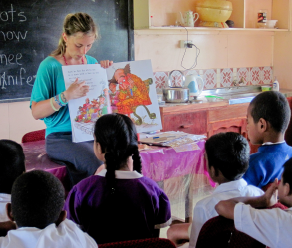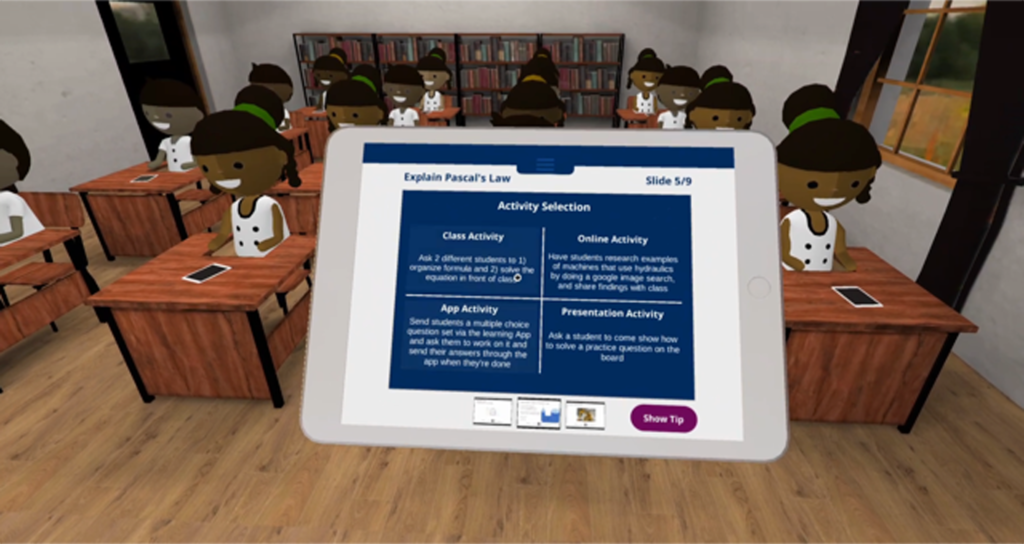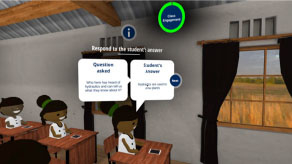
Virtual reality is a relatively recent phenomenon – and its use in classrooms more recent still. But as the accessibility to headset technology continues to open up, and the versatility of content continues to improve, virtual reality (VR) as an educative tool has become a real talking point. Earlier this year, research was released that found almost all teachers (94 per cent) in the UK thought that VR would benefit classroom teaching – and with the technology becoming increasingly affordable, it’s not difficult to imagine VR becoming commonplace in the classroom within just the next few years. But what about the benefits to teachers themselves? VR holds great potential as a training tool, not just for subject matter, but for the actual act of teaching itself. At Immersive VR, we’ve been working with Ericsson to create a training tool for teachers that opens up possibilities for the future of teachers, as well as students.
Educating the educators
Ericsson partner with Earth Institute, a part of Columbia University, to form Connect to Learn – a global initiative that supports education for those all over the world who wouldn’t normally have the opportunity to learn. Part of their work includes supporting teachers in areas of the world where training facilities are limited and teachers may have had little formal training. That’s where our involvement came in. We created a virtual reality training tool that would help teachers in the developing world become more confident and effective educators.
The tool places teachers in front of a virtual class of students, allowing them to practice the art of teaching, while such things as their body language and lesson delivery are measured, as well as their ability to attend to an easily-distracted class. In terms of skill-giving, it offers teachers with limited access to formal training a safe space to practice – but it also opens up opportunities and questions as to how VR can be used more widely to benefit the teaching community closer to home too. Before we explore those options, let’s understand exactly what VR is and how it aids learning.
The impact of VR on learning
Virtual Reality (VR) is the use of computer technology to create a simulated 3D environment. Users wear a specially-designed headset that immerses the viewer within that environment – giving them the ability to move around and interact with a world as much as possible as if they’re really there. In this way, VR can enable people to experience ‘the impossible’ – opening up all sorts of opportunities in the training and education sector, from creating engaging and interactive learning experiences to supplying practical training simulations for students and teachers alike.
The sense of physical presence enables the viewer to connect more completely with the story being told, or the experience they’re going through – which is proven to have a beneficial effect on learning. Indeed recent studies indicate that those learning in VR perform far better in tests than those learning in traditional environments. For example, a recent study conducted in China showed that students taught in a VR environment performed significantly better than those taught using traditional methods – on average 27.4 per cent better immediately after learning and 32.4 per cent better when tested two weeks later. What’s more, students who were underperforming in the traditional learning environment actually excelled in the VR environment – scoring 15.8 per cent better on average than the top students in the traditional environment.
This can largely be attributed to the fact VR provides a form of experiential learning, which has a greater impact on knowledge retention than traditional learning. In fact, an employment study found knowledge retention for those who go through traditional learning is only 5 per cent compared to 90 per cent for experiential learning. But what VR offers that other experiential learning can’t is the ability to re-run a scenario over and over again without having to worry about the consequences. This means it becomes the perfect training tool.

Boosting confidence, honing skills
The very essence of VR is its ability to transport the user to a completely different environment in both a believable and an engaging way, so it’s ideal for any sort of training where being able to perform a ‘dry-run’ and experiment with different scenarios and outcomes is useful. Teacher training is no different – especially during the early stages of learning the job, or where little training is available.
In our work with Ericsson and Connect to Learn, the ‘virtual classroom’ serves as a space for teachers to practice again and again before facing a real class. We ask the teacher to perform one of several set lessons from their curriculum and measure how they interact with the class. Pointers and feedback are provided both in real-time and in summary at the end of each session to help the user improve their skills. What’s more, the virtual students can be asked to perform a variety of tasks and activities and will react in different ways, meaning the simulation varies from session to session.
As a whole, the experience aims to provide practice and pointers on all aspects of teaching – from subject matter, to body language, to dealing with distracted students. Users gain live feedback on the volume of their voice, their visual engagement with their students and even the variation in their tone of voice, and if they don’t hit certain parameters within the virtual class – such as not asking enough questions or failing to move around enough – then the children become distracted and visually fade to prompt the user to vary their style of delivery, helping to hone their skills.
In addition to physical feedback markers, we also aim to teach more abstract pedagogical skills, such as how best to frame a response to a question from a student, or the importance of moving around the room to engage more fully with the whole class. The fully interactive experience uses aspects of gamification to monitor and assess the user’s performance, helping them hone the skills they need to teach a comprehensive lesson and keep a class’ attention in the process.
An example lesson plan:
In one of the lesson plans for the Ericsson project, the teachers are tasked with teaching their students about Pascal’s Law. They are given a brief at the start of the experience, which includes their aims. This is an overview of the tasks they have to carry out and the skills they get to practice during the experience. Each choice the teacher makes during the session has variable outcomes that determine how well they do.
Lesson aims
Today’s topic is Pascal’s Law. In this session you will:
- guide students through recall of prior knowledge as you introduce the topic
- present the concept through a brief lecture
- check for understanding of the concept
- You will practice the following pedagogical skills:
- backward design
- recalling prior knowledge and observation
- individual work
- student demonstration
- pair work
- You will have opportunities to engage your students in ICT-integrated activities, including:
- Google image search
- YouTube video
- collaborative learning platform
Teaching activities
Once you have introduced the topic, you will spend the remainder of your class guiding the students through activities to help them more fully grasp the concept and practice using the formula.
Choose two activities from among the four below. When choosing your activities, consider activities that:
- offer a mix of pedagogies
- include ICT- and non-ICT-integrated methods
- are in an order that you think will most effectively build students’ understanding
You will receive feedback on your choices at the end of the module.
Choose from:
- Ask 2 different students to 1) organise a formula and 2) solve the equation in front of class.
- Have students research examples of machines that use hydraulics by doing a Google image search, and share findings with class.
- Send students a multiple choice question set via the learning app and ask them to work on it and send their answers through the app when they’re done.
- Ask a student to come and show how to solve a practice question on the board.

Interaction points
Throughout the lesson, you will have points where you can interact with students. These include:
- asking a student a question
- inviting a student to write on the board
- complete a task using learning app
- ask students to complete task in pairs
In addition, the dynamic feedback mechanism built into the experience will cause students to ask questions if it gauges that teachers are not engaging students as well as they could be.
Feedback
At the end, the programme generates feedback on their teaching activities and on individual aspects of their class management, from the tone of their voice to the accuracy of setting time limits, based on the choices the teacher made throughout. The teacher can then repeat the experience if they so wish – with different variables and options available for them to experiment with, helping them to improve.
Less pressure, more progress
For teachers in developing countries, this is a way to train without access to the resources we have here in the UK – but these are skills that any new teacher can benefit from practising before they face the pressure of a real class. The global teaching community TES offers a handful of key tips on what makes a good teacher, including: knowledge of subject matter, classroom skills, planning skills, adaptability and communication skills. Often, these are skills that take time to build up as teachers gain more experience in the classroom. This is where a virtual simulator can come in really handy – by giving new and training teachers the confidence and initial experience of facing a class in a low-pressure, risk-free environment. For example, a training tool with similar functionality to that of the Ericsson Virtual Classroom can help a new teacher experiment with, and improve, their body language – helping them find the delivery style that best suits them and their class, making them a more open and more confident educator.
In the same way, it can help teachers prepare for the unpredictability of the classroom. No class is the same two days running and, while no digital application can replicate the true unpredictability of human nature quite so well as a real class, a virtual classroom can nonetheless help teachers get used to dealing with surprising situations such as student injuries or badly behaved pupils, which require quick thinking and flexibility. What’s more, it allows teachers to learn quick and adaptive thinking without the risk of alienating a class of real students who might lose respect for their teacher – while giving the teacher some of the confidence and skills they will need when faced with a real-life situation.
Such a training tool does not have to be limited to new or training teachers. Even those with years of experience in front of a real class could benefit from trying out lesson plans or refreshing their teaching style using a virtual classroom. A virtual class gives every teacher a chance to experiment and play with their craft, which is beneficial to continued professional development. Clinical psychologist Dr Daniel Freeman says there’s ‘something beautiful’ about how VR works because ‘people know it’s not real so they try things they’ve not done before or for a long time, but mind and body does behave as if it’s in the real world. And what they are doing is learning a new memory.’ In this way, practice with a virtual class will translate into dealings with a real class, which could be particularly useful if changing year groups or schools – situations where teachers need to re-adapt to a new audience.
Flexible technology
The Virtual Classroom we completed for Ericsson is designed to be a cover-all approach to the key skills needed to teach. But future teacher training simulators could be both more sophisticated and more targeted. For example, teachers could tailor the virtual class to them – for example by age range, class size, behavioural tendencies or intellectual level. They could also choose between delivering a normal lesson plan, a revision session, or even a non-specialist subject, such as sex ed. In this way, the user could set up a virtual class of students that most resemble their own and get the maximum benefit of the training.
What’s more, VR doesn’t necessarily require bulky or expensive equipment. For the Ericsson project, the simulation we produced works on mobile phones which plug into portable plastic headsets. This is a cost-effective and portable solution that still provides a good experience for the user. It’s certainly a continuing trend that the equipment is becoming more ubiquitous and cheaper as time goes on.
Thoughts for the future
VR is proven to have a beneficial effect on learning – and it’s a platform that’s becoming increasingly easy to access. With that in mind, it’s easy to see how VR will be adopted for aiding student learning. But there is also an opportunity for teachers. If educators are increasingly engaging with this technology as a way of practicing complex scenarios in a risk-free way outside of the classroom, it stands to reason it should lead to greater confidence and better teaching inside the classroom as a result. This is particularly pertinent to teachers in training and those who are still new to teaching who would benefit from a safe way to practice the skills needed to succeed in a demanding and often high-pressured environment.
With the technology improving all the time, virtual training simulations are only set to get more life-like and more engaging. Virtual training is a sector that’s already rapidly growing – in just a few years we can expect it to be much more widespread. The education sector can benefit from this too. Teaching today is a demanding vocation that requires multiple skills – a virtual classroom offers a safe space and a helping hand to gain them.
Lorna Burrows is the Head of Content at Immersive VR where she helps craft engaging, informative and educative experiences for the likes of Ericsson, British Red Cross and Harley Davidson. https://www.immersivevr.co.uk/
Register for free
No Credit Card required
- Register for free
- Free TeachingTimes Report every month